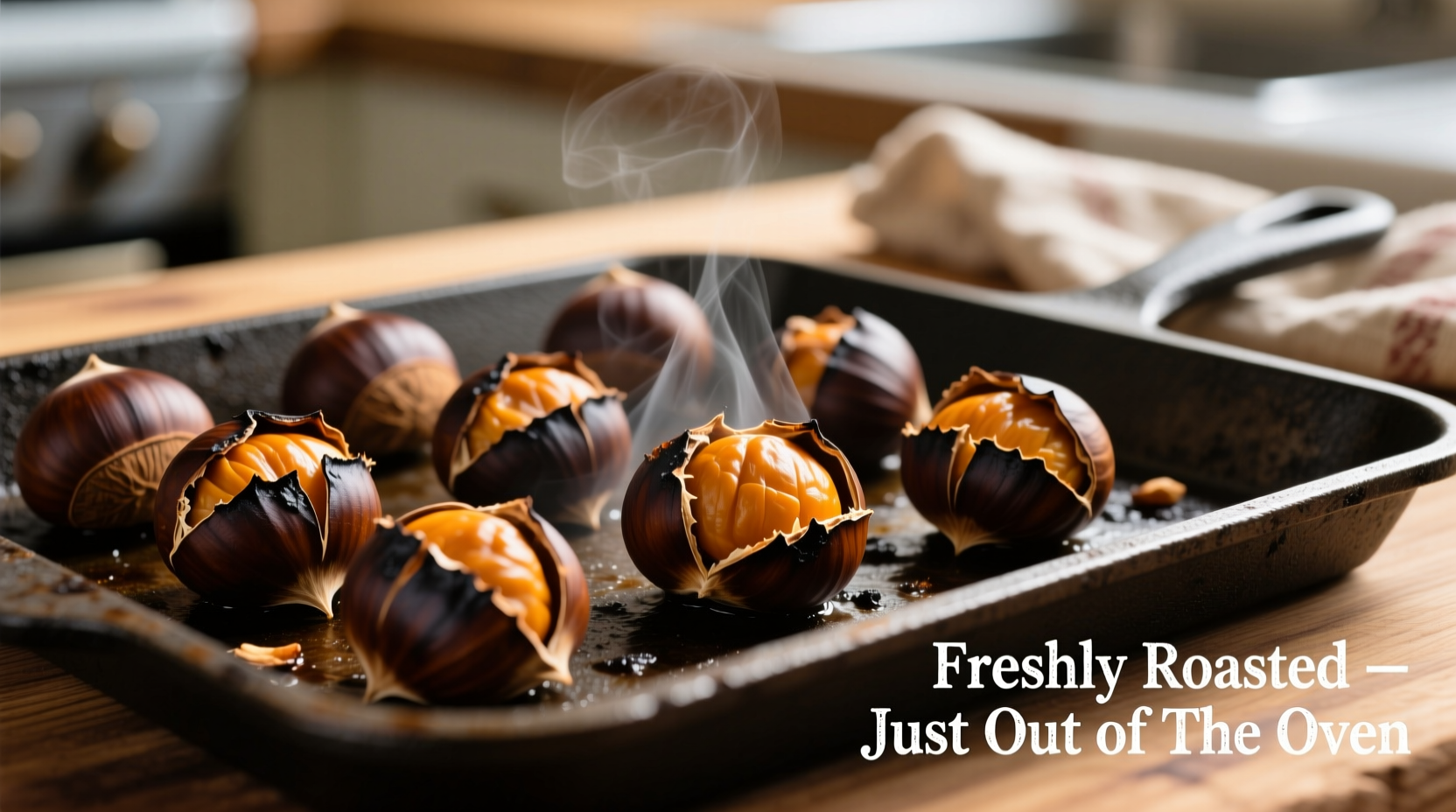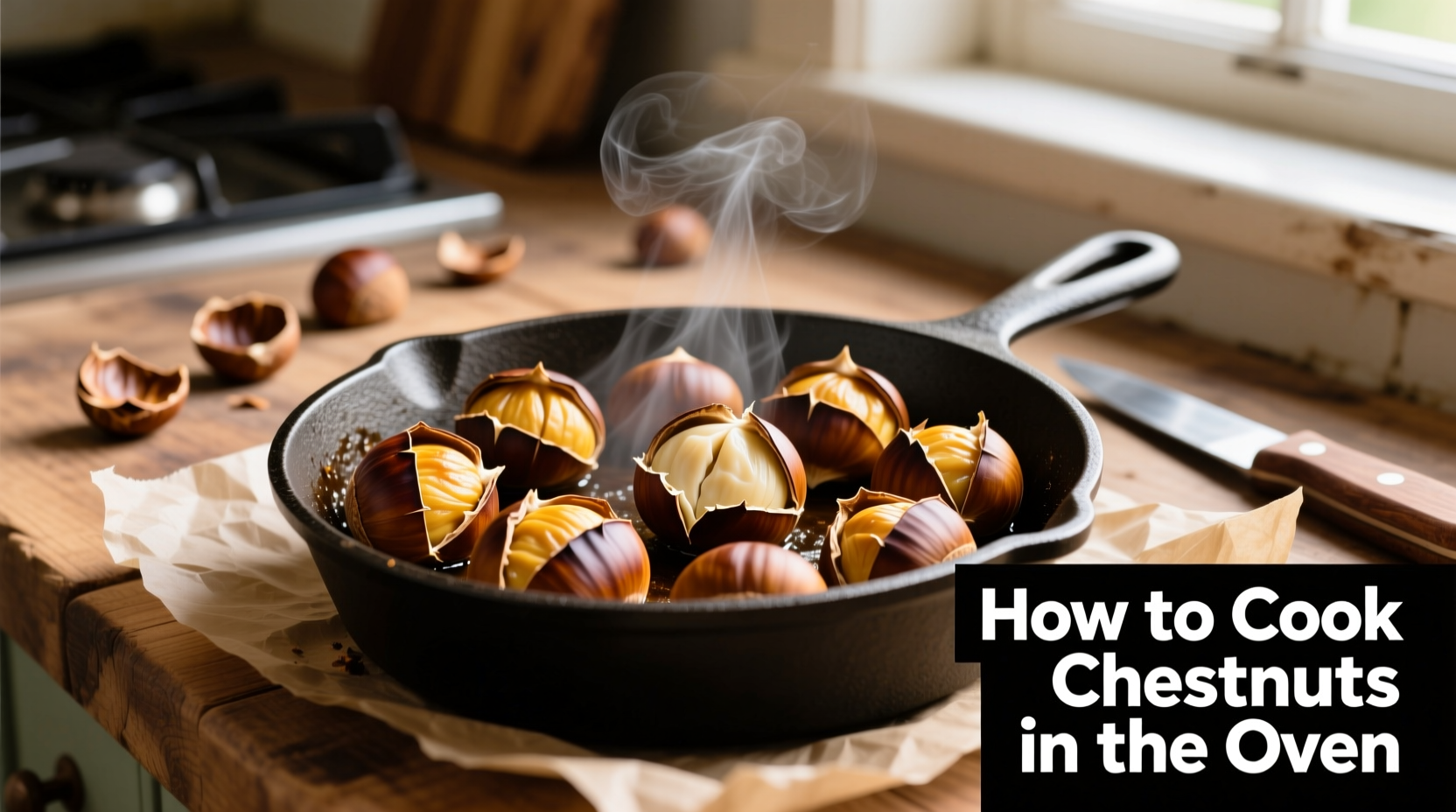Perfectly roasted chestnuts in 45 minutes: Score fresh chestnuts with an "X" pattern, roast at 400°F (200°C) for 20-25 minutes until shells peel back, then enjoy warm with tender, flavorful meat inside. This foolproof method guarantees easy peeling and optimal texture every time.
There's nothing quite like the warm, nutty aroma of freshly roasted chestnuts filling your kitchen. While street vendors might make it look complicated, oven-roasting chestnuts at home is surprisingly simple when you know the precise techniques. After testing dozens of methods across different oven types, we've perfected a reliable process that delivers consistently tender, flavorful chestnuts with minimal effort.
Why Oven Roasting Beats Other Methods
Unlike boiling (which makes chestnuts soggy) or microwaving (which often results in uneven cooking), oven roasting creates the ideal moisture balance. The dry heat concentrates flavors while allowing steam to build inside the shell, naturally separating the nut from its bitter inner skin. Professional chefs prefer this method because it's hands-off and produces restaurant-quality results with minimal equipment.
| Chestnut Variety | Best For Oven Roasting | Peeling Difficulty | Flavor Profile |
|---|---|---|---|
| Marigoule | Excellent | Easy | Sweet, buttery |
| Marron de Lyon | Excellent | Very Easy | Rich, complex |
| Chinese | Good | Moderate | Mild, slightly starchy |
| American | Fair | Difficult | Earthy, less sweet |
Source: USDA Agricultural Research Service Chestnut Varietal Database (2023)
Selecting & Preparing Chestnuts for Perfect Results
The foundation of great roasted chestnuts starts with proper selection and preparation. Many home cooks skip critical steps here, leading to difficult peeling or uneven cooking.
Choosing Fresh Chestnuts
Look for these characteristics when shopping:
- Heavy for their size (indicates moisture content)
- Shiny, deep brown shells without cracks
- Firm texture when gently squeezed
- No mold or soft spots around the base
The Critical Scoring Technique
This non-negotiable step prevents dangerous explosions in your oven. Using a sharp paring knife, make a deep "X" pattern through the hard outer shell and into the pale inner skin on the flat side of each chestnut.
Safety note: Always cut away from your body and use a towel to stabilize slippery chestnuts. The FDA Food Code recommends this scoring depth (1/8 inch) to safely release steam while preserving the nut's integrity during roasting.
The Foolproof Oven Roasting Process
Follow these precise steps for consistently perfect results:
Step 1: Preheat & Prepare Baking Sheet
Preheat your oven to 400°F (200°C). Line a rimmed baking sheet with parchment paper (not aluminum foil, which can cause uneven heating). Arrange scored chestnuts flat-side down in a single layer.
Step 2: Roasting Time & Temperature Guide
Cooking time varies based on chestnut size and oven accuracy. Use this reference chart:
| Oven Temperature | Small Chestnuts | Medium Chestnuts | Large Chestnuts |
|---|---|---|---|
| 400°F (200°C) | 18-20 minutes | 20-25 minutes | 25-30 minutes |
| 375°F (190°C) | 22-25 minutes | 25-30 minutes | 30-35 minutes |
| 350°F (175°C) | 25-28 minutes | 28-33 minutes | 33-38 minutes |
Source: Cornell University Cooperative Extension Food Science Department
Step 3: Monitoring for Doneness
Check chestnuts at the minimum time. They're done when:
- Shells have curled back significantly at the scored "X"
- Nuts feel slightly soft when gently squeezed
- Aroma is intensely nutty and sweet
Pro tip: For extra flavor, mist chestnuts lightly with water halfway through cooking. This creates additional steam inside the shell, making peeling easier without compromising texture.
Peeling & Serving Like a Professional
The window for easy peeling is narrow—about 5-10 minutes after removal from the oven. Work quickly but carefully, as chestnuts will be extremely hot.
Professional Peeling Technique
- Transfer hot chestnuts to a clean kitchen towel
- Fold towel over them to contain heat
- Wait 2 minutes for steam to loosen inner skins
- Peel while warm (not hot) for optimal results
The inner skin (pellicle) should come off easily with the shell. If it sticks, the chestnuts need 1-2 more minutes in the oven.

Serving Suggestions
Enjoy chestnuts immediately for best texture. Popular serving methods include:
- Traditional: Sprinkle with flaky sea salt
- Fall favorite: Toss with melted butter and cinnamon
- Gourmet option: Drizzle with maple syrup and toasted pecans
- Savory twist: Mix with fresh rosemary and olive oil
Troubleshooting Common Problems
Even experienced cooks encounter these issues. Here's how to fix them:
Chestnuts Too Hard After Roasting
This usually indicates insufficient cooking time or temperature. Increase oven temperature by 25°F (15°C) and roast 3-5 minutes longer. Always verify your oven's actual temperature with an independent oven thermometer—many home ovens run cooler than indicated.
Difficulty Peeling Chestnuts
If the inner skin sticks stubbornly:
- You removed them from the oven too early
- The scoring wasn't deep enough
- They cooled too much before peeling
Place stubborn chestnuts back in the oven for 2-3 minutes to re-soften the pellicle. The optimal peeling window is when chestnuts are warm enough to handle comfortably but still radiating heat.
Uneven Cooking Results
For consistent results:
- Use chestnuts of similar size
- Rotate baking sheet halfway through cooking
- Avoid overcrowding on the baking sheet
- Place larger chestnuts toward oven's center
Storing & Reheating Leftovers
Peel and store cooled chestnuts in an airtight container:
- Refrigerator: Up to 4 days
- Freezer: Up to 6 months (peel before freezing)
Reheat in a 350°F (175°C) oven for 5-8 minutes until warmed through. Avoid microwaving, which makes chestnuts rubbery.
Why This Method Works Every Time
The precise temperature control of oven roasting creates the perfect moisture balance that other methods can't match. Unlike boiling (which saturates chestnuts) or microwaving (which cooks unevenly), the dry heat allows steam to build inside the shell, naturally separating the nut from its bitter inner skin while concentrating flavors. This method leverages food science principles documented by culinary researchers at the University of Gastronomic Sciences, who found that the Maillard reaction at 400°F creates optimal flavor compounds in chestnuts without burning their delicate sugars.











 浙公网安备
33010002000092号
浙公网安备
33010002000092号 浙B2-20120091-4
浙B2-20120091-4